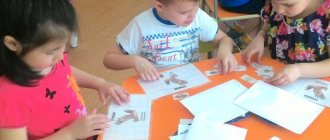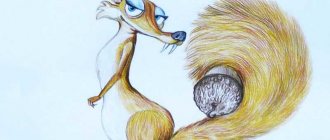Summary of a lesson on ecology in the senior group. Topic: Insects
Summary of a lesson on ecology in the senior group “In the world of insects”
Author: Natalia Aleksandrovna Kovtun, teacher at MBDOU kindergarten “Teremok”, p. Izhevskoe, Ryazan region. Description of the material: This summary may be useful for educators working with children of senior preschool age. You can use this material during the implementation of pedagogical projects about insects in kindergarten.
Goal: In a fun way (using poems, riddles, games) to introduce preschoolers to the world of insects. Objectives: 1. To acquaint children with the essential characteristics of insects, develop the ability to draw conclusions, and establish cause-and-effect relationships between natural objects. 2. Develop an interest in insects and a desire to learn interesting information about them. 3. Cultivate a love of nature, a caring attitude towards all life on Earth. Materials and equipment: homemade puzzles - butterfly, ant, grasshopper (print colorful images of insects on thick A4 sheets and cut into several parts), pictures with images of a ladybug, caterpillar, ant, butterfly, dragonfly, 3 small tables, magnetic board, magnets .
Progress of the lesson:
(Children sit on the carpet)
Educator: Guys, let's imagine that you and I find ourselves in a forest clearing. Who can we meet here? (animals) That's right, but animals are afraid of people and try to avoid them. But there are people in the forest who are not afraid of us. They are very, very small and there are a lot of them everywhere - in the air, on the ground, on trees, flowers. Who do you think it is? (these are insects) Here is a grasshopper crackling in the grass, (Author - V. Leonov) A butterfly is soaring in the sky, A furry, loud, striped bumblebee is buzzing on a flower. Insects fly, jump, crawl, soar, surprise us with their beauty, and also bring benefits! Educator: Guys, what insects do you know? (children's answers) Well done, right! Now, guess the riddles. (after the children guess the riddle, the teacher attaches the corresponding picture to the magnetic board) 1. She is the cutest of all the bugs, Her back is scarlet. The circles on the back are little black dots. (ladybug)
2. He is a real worker, very, very hard-working. Under a pine tree in a dense forest, he builds a house from needles. (ant)
3. She is bright and beautiful. Graceful, light-winged. She looks like a flower and loves to drink flower juice. (butterfly)
4. Hairy, green, she hides in the leaves, although she has many legs, she cannot run. (caterpillar)
5. She has four wings, a thin body like an arrow, and big, big eyes. They call it... (dragonfly)
Educator: Well done, guys! All the riddles were guessed correctly. (the teacher, together with the children, identifies the essential features of insects - six legs, wings, antennae, a jointed body) Educator: You know, guys, insects are the most ancient and numerous inhabitants of our planet.
They appeared many, many millions of years ago and are perfectly adapted to life on Earth. What do you think insects eat? (children's answers) Each insect has its own food. Caterpillars (butterfly larvae) eat leaves, flowers and fruits of plants. There are harmful types of caterpillars, and there are also those that destroy other insect pests and thereby help people. Butterflies collect nectar from flowers and pollinate plants. Ladybugs eat aphids and also bring great benefits. But mosquitoes feed on plant sap and animal blood. Insects are an excellent treat for birds, frogs, lizards and other animals. You can learn a lot about the life of insects. And you can meet them not only in the forest. You've probably already met them. What insects did you see? (children’s answers) Game “Pick a sign”
what kind of butterfly? (beautiful, light) what kind of caterpillar? (green, slow) what ant? (small, hard-working) What kind of bee? (striped, buzzing)
Game “Make an insect”
(children are divided into groups of several people and assemble homemade puzzles on the tables - a butterfly, an ant, a grasshopper)
Physical education
Raise your shoulders, jump, grasshoppers! Jump - hop, jump - hop, sat down, ate some grass, listened to the silence, Higher, higher, higher! Jump on your toes with ease!
Educator: Guys, you should know that there are dangerous insects and learn the rules of behavior when meeting them: If there is a bee, wasp, or bumblebee nearby, you should not wave your arms. You need to step aside and behave calmly. Exposed areas of the body are treated with special insect bite repellents (with the help of adults). If, for example, you are bitten by a bee, you should immediately seek help from adults (parents, teachers). Educator: Guys, what do you think will happen if insects suddenly disappear? (plants and many animals will die) That’s right, because in nature everything is interconnected - some cannot live without others. Insects are part of nature, just like you and me. Therefore, all life on Earth must be preserved and protected! Listen to the poem: There is a huge house on Earth (Author - L. Daineko) Under the blue roof. The sun, rain and thunder, forest and sea surf live in it. Birds and flowers live in it, the cheerful ringing of the stream. You live in that bright house, you and all your friends. Wherever the roads lead, you will always be there. This house is called the nature of our native land. Educator: Guys, did you like our lesson? What new did you learn today?
We recommend watching:
Environmental project in the senior group on the topic: Insects Educational project in kindergarten “Insects” for children in the senior group Summary of educational activities for children of the preparatory group in kindergarten with a presentation. Insects Ecological tale about an Ant for children 5-7 years old
Similar articles:
Lesson summary for the senior group on the topic: Insects and flowers
Poems about insects for preschool children 5-6 years old
Conversation about the caterpillar for children
About beetles for children 5-8 years old
About mosquitoes for children
Lesson notes for senior group on the topic “Insects”
Lesson summary on the topic: “Insects” (senior group)
Goals:
EDUCATIONAL:
- Expand and consolidate children’s knowledge about insects, introduce the general concept “insects” into children’s active vocabulary. Continue to practice composing sentences of different constructions using the conjunction because. Continue learning to compose a short story based on a series of paintings.
EDUCATIONAL:
- Cultivate a kind attitude towards our little neighbors around the planet.
DEVELOPMENTAL:
- Develop visual and auditory memory.
- Activate and enrich children's vocabulary on the topic.
- Develop coherent speech.
- Develop figurative speech.
- To develop children’s verbal and logical thinking, the ability to establish cause-and-effect relationships, reason, draw conclusions, eliminate the fourth extra object with justification for their answer.
- Continue to teach how to solve riddles and justify your answer.
- Develop gross motor skills and coordination.
- Continue learning to group objects according to basic characteristics.
Equipment:
subject pictures of insects (butterfly, bee, grasshopper, ant, caterpillar, ladybug, dragonfly).
Flower, didactic game “Arrange in groups”, didactic game “Fourth odd”, D/i “What comes first, what comes next” (story pictures showing the transformation of a caterpillar into a butterfly). A soft toy - a caterpillar, a table covered with a green cloth on which there are flowers, a letter, insect toys - a bee, ladybug, dragonfly, ant, beetle, fly. Progress of the lesson:
Educator: Hello, my name is Tamara Ivanovna, I came to you from Allaikha, which is located in the north of our republic.
Today I will give you a lesson on getting to know the world around you. Topic: "Insects." We will expand and consolidate our knowledge about insects, continue to practice composing sentences of different structures using the conjunction because. Let's continue to learn how to write a short story. So, we begin our lesson. You are ready? - Today we will go to visit the small inhabitants of the forest clearing
-
insects. 2. Organizational moment.
Educator: - Look, there is no one in the clearing, I don’t see a single insect. The evil spider has bewitched the insects. Only the letter is there. Let's read the letter: “Dear guys, we are in trouble, an evil spider has bewitched us, please help us! Insects". We can save them if we complete all the spider’s tasks.
3.Introduction to the topic.
Educator: - Guys, something happened to the six-legged babies, are you ready to help?
The teacher reads the text: Once upon a time, an evil spider flew over the insects In a multi-colored clearing He bewitched everyone. So that the butterflies flutter, the ant works. And so that the wasps buzz, you help quickly. Take knowledge with you, and take kindness, and help these six-legged babies! Educator: - And to help our six-legged kids, you and I will also turn into insects. I have a magic flower that will help us. The teacher takes a magic flower and says the words together with the children: - Close all your eyes and repeat after me: - Help us, flower, turn us into insects! So you and I have turned into insects and we will fly to a forest clearing. Come on, insects, sit down. And here is the first task from the spider: “You need to solve riddles and find pictures - answers.” 4.Riddles.
Conversation on the topic. The teacher reads the riddles, the children guess, find the picture and put it on the flannelgraph.
- She has four wings
The body is thin, like an arrow. And big, big eyes, They call her... (dragonfly). Educator: - How did you guess that it was a dragonfly, what words helped you find the answer?
- Drinks the juice of fragrant flowers,
Gives us both wax and honey. She is sweet to all people. And her name is... (bee). Educator: - What words helped you guess that it was a bee?
- He is a real worker
Very, very hard working. Under a pine tree in a dense forest, he builds a house from needles. (ant). Educator: - What words helped you guess that it was an ant?
- She is bright, beautiful,
Graceful, light-winged. She looks like a flower and loves to drink flower juice. (butterfly). Educator: - What words told you that it was a butterfly?
- She is dearer than all the bugs,
The back is scarlet. And on it are circles, little black dots. ( Ladybug). Educator: - And in this riddle, what words suggested that it was a ladybug?
— How can you call in one word those depicted in the pictures? —What is the main characteristic of all insects? (All insects have 6 legs.) - Is a spider an insect? - Name insects that are predatory (dragonfly, grasshopper, ladybug) - Why are they called predators? (Because they hunt for other insects.) - Name the beneficial insects. (butterfly, bee, ant.) - What benefits do bees, butterflies, ants bring? (Bees pollinate flowers, give us honey and wax. Ants carry the seeds of many plants throughout the forest. Butterflies pollinate flowers.) - Name the harmful insects. (Fly - carries germs, caterpillar - eats plant leaves, mosquito.) - Well done, you guessed all the riddles, and we saved the dragonfly and the bee, but other insects are also waiting for our help, let's move on. 5. Physical exercise “Centipede”
1. A centipede walked (children walk with a rhythmic step, slightly springing) along a dry path.
2. Suddenly it began to rain: Drip-drip-drip! (children stop and crouch.) - Oh, forty paws will get wet! 3. I don’t need a runny nose (children walk with their knees raised high, as if they are walking through puddles). I’ll go around the puddles! 4. I won’t bring dirt into the house (the children stop and shake one leg), I’ll shake it with each paw! (shakes the other leg). 5. And then I’ll stomp (children stomp their feet) - Oh, what thunder from the paws! Educator: - Let's go further, there are other insects waiting for our help. Children sit near the flanalegraph. There are pictures on the flannelograph. 6. Game "4 extra".
Making sentences with the conjunction “because”. Educator: - Look carefully at the pictures and tell me which picture is superfluous here and why do you think so?
- An extra spider because it is not an insect.
- There is an extra ant because it does not fly, while other insects fly.
- There is an extra butterfly because it flies, but other insects do not fly.
- An extra bee, because the rest of the insects are predatory.
Educator: - Here you and I also saved an ant (an ant appears). Let's continue our journey. 7. Game “Put the butterflies into groups”
(on the carpet).
Educator: - Look how beautiful the butterflies have flown to us. I suggest putting them into groups. Katya, arrange the butterflies. Educator: - Katya, on what basis did you sort the butterflies? The child explains: -I arranged the butterflies according to shape. Educator: - And now Diana will put the butterflies into groups, but in a different way. Diana, by what criteria did you sort the butterflies? Child: - I arranged the butterflies by color. Educator: - By what other criteria can butterflies be classified? Children's answers: - By size. Educator: - Arina, arrange the butterflies by size. Educator: - So we freed the grasshopper and the beetle. What a great fellow you are! (A grasshopper and a beetle appear). Educator: - Let's continue the journey. (Children sit on chairs) 8. Didactic game “What first, what next.”
A caterpillar appears, grumbling, very dissatisfied: “Everything about butterflies, and about butterflies, but they forgot about me.”
Educator: -No, they didn’t forget the caterpillar. We will help you turn into a butterfly. Guys, let's help the caterpillar turn into a butterfly. The teacher conducts a conversation: - What does the butterfly lay first? Children's answers: - The butterfly lays eggs. Educator: - Who comes out of the egg? Children's answers: - A caterpillar emerges from an egg. Educator: - What does the caterpillar do? Children's answers: - She eats leaves and grows. Educator: - Who is she turning into? Children's answers: - The caterpillar turns into a chrysalis. Educator: - Who comes out of the chrysalis? Children's answers: - A butterfly emerges from a pupa, its wings are wet. The butterfly dries its wings in the sun; as soon as the wings are dry, the butterfly begins to fly. Educator: - I suggest you tell me how a caterpillar turns into a butterfly from the pictures. 9. Physical education session - coordination of speech with the “Centipede” movement. 10. Children's stories in a chain:
- A butterfly laid eggs on a flower.
- Then the caterpillar appeared.
- The caterpillar ate the leaves and grew.
- Then the caterpillar turned into a chrysalis.
- Here a butterfly emerges from a pupa. Her wings are wet. A butterfly dries its wings in the sun. As soon as the wings dry, the butterfly begins to fly.
11. Summary of the lesson.
Educator:
Our journey has come to an end, what a great fellow you all are for helping the insects.
It's time for us to go back to kindergarten. But first we need to turn into children again. The teacher takes a magic flower and says the words: Close your eyes and repeat after me: “You are a flower, help and turn us into children!” — Did you like being insects? - And if you had the opportunity to turn into insects again, who would you like to turn into and why? — Which game did you like best? - You were all great today! The insects thank you all and they have settled in our forest clearing. Look how beautiful the clearing has become. Let ants and beetles crawl on the ground, let grasshoppers jump on the grass, let butterflies and dragonflies fly, and let the world we live in always remain blue and green! 12. Relaxation. “The Flutter of a Butterfly”
Guys, today we traveled a lot, we were tired. Let `s have some rest. Lie down on the mat, close your eyes and remember how you were insects.
Imagine a beautiful summer day. You are lying on a green meadow. Everything around is calm and quiet. You feel warm and comfortable, you breathe easily and calmly. Imagine that you are light butterflies with large and beautiful wings. Your arms are light and light—like the wings of a butterfly. And your body also became light, light, flapped its wings and flew. With every inhalation and exhalation you float higher and higher in the air. A light breeze gently strokes your wings... (pause - stroking the children). Strokes, gently touches... (name). You feel good and pleased. But now it's time to return home. Stretch and on the count of three, open your eyes. Smile at each other.



